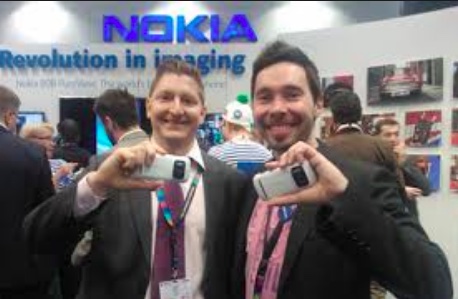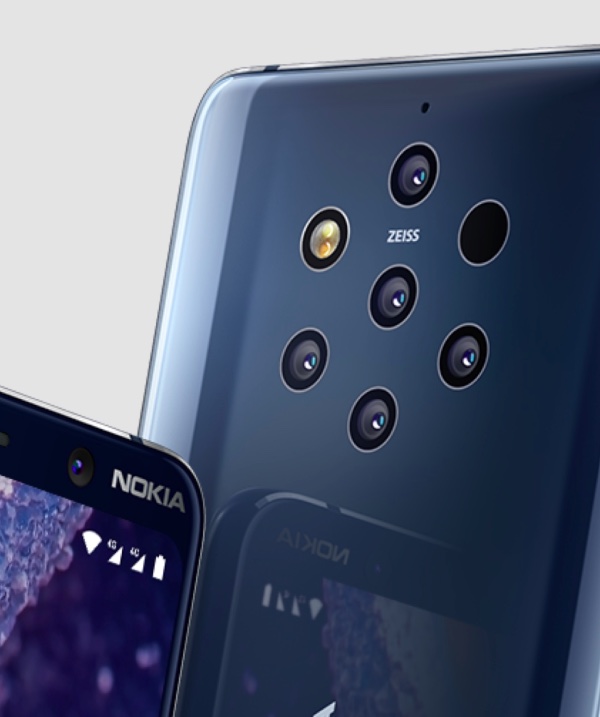 Before leaping ahead to the imminent retail release of the new Nokia 9, plus numerous 48MP sensored phones and even the re-emergence of optical zoom, I do want to recap a little. The 808 PureView started life because Eero Salmelin and Juha Alakarhu had an idea to replace the bulky and complex optical zoom mechanism of the Nokia N93 with a single, fixed optical block and a super high resolution sensor, simply smart-cropping into this sensor to achieve up to 2.5x zoom for 5MP stills and 4x zoom for 1080p video.
Before leaping ahead to the imminent retail release of the new Nokia 9, plus numerous 48MP sensored phones and even the re-emergence of optical zoom, I do want to recap a little. The 808 PureView started life because Eero Salmelin and Juha Alakarhu had an idea to replace the bulky and complex optical zoom mechanism of the Nokia N93 with a single, fixed optical block and a super high resolution sensor, simply smart-cropping into this sensor to achieve up to 2.5x zoom for 5MP stills and 4x zoom for 1080p video.
Once conceived, they also wondered what to do with all the pixels when an image (or video) wasn't zoomed. And here's where the 'PureView' name came in - groups of pixels in the underlying sensor could be intelligently combined ('oversampling') to reduce random noise from individual sensor pixels, i.e. each pixel in the 5MP output image would be 'purer'.
The idea relied on a custom Image Signal Processor to handle the billion pixel-level calculations per second (in video mode) and the '808 PureView (yes, running Symbian^3) was launched to significant acclaim, at least among imaging enthusiasts in the phone world. In fact, the 808 is still held up by some in 2019 as the benchmark that everything else has to beat.
The arrival of the Lumia 1020 a year later, running Windows Phone 8.0, somewhat diluted the PureView idea in terms of performance - where the 808 processed images in under a second, the 1020 had no custom ISP and shot to shot times were around four seconds, slow even for 2013. But imaging purity was just as good - in fact better, since there was newer generation of sensor, Back Side Illuminated (BSI), plus rudimentary OIS (based on ball bearings!) to enable low light photos with longer exposures.

All this was six years ago, an eternity in the phone world, but it does seem, in 2019, that the world itself is largely catching up. It was said in 2012 that the 808 was five years ahead of its time, i.e. ahead of the competition, and this proved about right, with other phone cameras only creeping ahead of the PureView pair in the last two or three years. (The Lumia 950 also used PureView ideas, with even more modern sensor and even better OIS, and I'd rate the 950 as phone camera champion between 2016 and 2018.)
So yes, tech is catching up in various ways:
- Chipsets and ISPs have got massively faster, to the extent that phone cameras can take multiple short shots every time you snap a subject and fuse the images together, effectively combining pixels in the time domain (championed by the HDR software in the Google Pixel range), rather than the physical domain.
- Sensor resolutions have crept up and up, to the point where pixel-binned 48MP sensors are now common on 'budget flagships', i.e. higher resolution than on the original PureView, though without the same degree of software sophistication, I'd argue. 'Pixel-binning' implies blocks of four pixels of the same 'colour' being reduced down to one, so 48MP bcomes 12MP for the final image, and so on. It's all a bit crude, but it generally works and the smart-cropping for zoom works too, to a degree.
 Optical zoom is making a comeback, with two manufacturers (Oppo [shown right] and Huawei) demonstrating 'periscope' zoom mechanisms, with the light bounced off a prism and then the lengthy zoom optics being carried through the length and/or width of the phone rather than in the depth/thickness (as, arguably, depending on which way the phone was perceived, on the old 2006 Nokia N93).
Optical zoom is making a comeback, with two manufacturers (Oppo [shown right] and Huawei) demonstrating 'periscope' zoom mechanisms, with the light bounced off a prism and then the lengthy zoom optics being carried through the length and/or width of the phone rather than in the depth/thickness (as, arguably, depending on which way the phone was perceived, on the old 2006 Nokia N93).
Put the three factors together and the world of phone imaging is getting very interesting again.
It's true that overall image quality has been increasing steadily from year to year, with the likes of the Google Pixel range arguably matching the Lumia 950 last year (see the PS below for some head to head links of interest), to the point where most people will be happy with a photo taken of a static subject taken on the camera of almost any phone over about £200 in 2018/2019.
Meaning that other imaging aspects are now the differentiators. We've seen wide angle lenses, famously on the LG flagships and now copied on phones from Huawei and Samsung. These are useful but arguably a one-trick pony.
What's more interesting still is that zoom is making a comeback. Being able to accomplish genuinely lossless zoom again, just as on the original PureView pair, but taken to new heights, and with far faster chipsets to power even more complex computational photography.
"Oh, I wouldn't use zoom" is something you might hear from an average phone user. But once they realise that zoom lets them get closer to their subjects, optically, with less physical intrusion, once they try zooming and are amazed by the quality possible, I'm predicting that zoom will become more and more an essential part of the camera phone world. The majority of phones over about £200 now have dual cameras and many of these include a 2x or 3x telephoto lens - and these are hugely popular. It's noteworthy that small telephoto lenses aren't great in really low light, but the use of OIS on the best of them (I own a Galaxy S9+) mean that exposures can usually be lengthened enough that the camera software doesn't have to resort to falling back on another lens and lossy zoom.
 At which point we come to the Nokia 9, announced last week. The 'PureView' brand lives again and I think it's justified, even if the implementation isn't quite what the 2012/2013 pair of phones put into practice. With the Nokia 9, it's all about shooting each shot with five essentially identical cameras (ok, so three are monochrome, but should allow for more light capture and/or shorter exposure times overall) and then combining RAW information with suitable algorithms to produce a super 'pure' image with tremendous dynamic range. This alone, despite the lack of crowd pleasers like wide-angle optics and OIS, should be enough to justify the brand name.
At which point we come to the Nokia 9, announced last week. The 'PureView' brand lives again and I think it's justified, even if the implementation isn't quite what the 2012/2013 pair of phones put into practice. With the Nokia 9, it's all about shooting each shot with five essentially identical cameras (ok, so three are monochrome, but should allow for more light capture and/or shorter exposure times overall) and then combining RAW information with suitable algorithms to produce a super 'pure' image with tremendous dynamic range. This alone, despite the lack of crowd pleasers like wide-angle optics and OIS, should be enough to justify the brand name.
(There's also lots of much-hyped 'depth' analysis and better 'bokeh' control, but - while welcome - that's another subject for another feature and will also require extensive testing while I get to grips with exactly how the five lens system works.)
Curiously, and rather appropriately, much of the criticism of the Nokia 9 so far has centred on the 'processing' delays in the background. This is perhaps justified, though the Lumia 1020 took well over three seconds to oversample its internal RAW image, while the Lumia 950 streamlined things a bit by pushing the oversampling to the background ('Processing') and letting users carry on shooting of doing other things. This too is the approach taken in the Nokia 9, with the processing of five RAW images taking anywhere between ten and thirty seconds, depending on what your subject is. For the imaging enthusiast, as long as this is in the background and as long as you trust the software, this isn't necessarily an issue, since the end result should be worth waiting for - but a 'casual snapper' this isn't.
So we have purity and dynamic range, but - returning to the title of this feature - what about zoom? I'm down for a review Nokia 9, of course, but no one's really talked about assembling a lossless zoom from five images from slightly different viewpoints, so we just don't know yet. I do get the impression that Nokia is still working frantically on its software, with a huge update appearing in the last couple of days, and I'm hopeful that part of the background processing can be routed to allow a degree of lossless zoom, i.e. using data from other cameras to fill in gaps 'between pixels' in the alternates. It's 'just' a computer science problem and can be done in maths. It just might take a bit more processing power!
So the '9' deserves the 'PureView' brand. What readers of AAS and AAWP want to know is whether the Nokia 9 is a spiritual successor to the 808 and 1020. I think so, though an exact ranking will depend on tests, and lots of them. Low light, Very bright. Zoom. And so on. And I'll bring you those tests later in March, by which time Nokia will have had time to push out more updates so watch this space!
